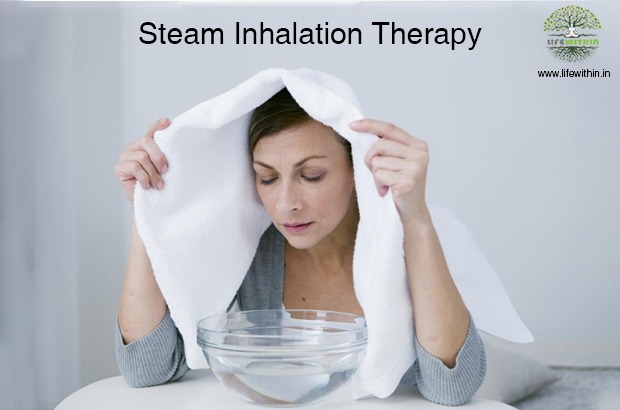Steam Inhalation Therapy For Common Respiratory Infections | Dr. Vikram Chauhan
Steam inhalation therapy is practiced to ease symptoms of such infections. In this article, we shall see what steam inha...
- by Life Within Editor
- May 31, 2021
- 1359 views

Steam Inhalation Therapy:
ABSTRACT
During the change of seasons, congestion in the nose is common and can happen due to a variety of reasons. If the person has caught an infection, the congestion lasts for around 3 days and is accompanied by some physical symptoms such as fatigue and slight fever. Common respiratory infections are caused by some viruses that are not harmful for life. But, they can be a symptom of other illnesses that are more serious and last for more than a week. Steam inhalation therapy is practiced to ease symptoms of such infections. In this article, we shall see what steam inhalation is, how it works on our upper respiratory tract, the right way to do it and the care and precautions everyone should know and follow while giving someone or taking steam inhalation therapy.
Introduction
Steam inhalation is practiced as a therapy for
relieving common cold and similar discomforts of our upper respiratory tract.
Almost all the uncomfortable conditions of the nose are first characterized and
brought to our notice by congestion in the upper respiratory tract and
sometimes by dripping mucus in the throat.
Our upper respiratory
tract
The ‘upper respiratory tract’ includes the nose, the
nasal cavity, the sinuses (small spaces in the skull for facilitating breathing
and housing optic and olfactory nerves) at the sides and back of the nose, the
pharynx, the larynx, and the part of the wind pipe until here. Inside the upper
respiratory tract there is a healthy lining of mucus at all times so that it
can trap and expel any foreign particles or microorganisms that enter it
through the nose or the mouth. When a particle of dust, dirt, mold, hay, or a
microbe such as a virus (most respiratory infections are caused by viruses
only) enters the upper respiratory tract, the mucus –producing cells in the
sinuses and the throat increase its production and makes it thinner, so that
the foreign particle or microorganism can be flushed out before it harms the
body. This is seen by us as congestion since it makes respiration through the
nose difficult.
The mechanism of steam
inhalation
The flooding of nasal passages and throat with mucus
makes us very uncomfortable since we think of it as a disorder, while it is a
part of the natural response of the body’s immune system. Nevertheless, it
makes breathing uneasy. To get rid of this uneasiness, sometimes oral
medications in the form of syrup and tablets are used so that the mucus dries
up; while at other times nasal sprays are used. But, one method involving no
medications is steam inhalation. A bowl with a wide mouth is filled with
boiling water and the sick person is required to bend over it and cover the
space between the bowl and their head with a towel. The steam rising from the
bowl enters the upper respiratory tract on its own during inhalation by either
the mouth or the nose.
Importance of steam
inhalation during an infection
When a potential virus enters the body through the
nose or the mouth, it takes some time for symptoms to show up. This time is
called the incubation period of the virus and is counted in the number of days.
If you know you have been exposed to some virus or have come in close contact
with someone who is sick, steam inhalation should be started as soon as
possible at home. The reason is that while the virus is still in its incubation
period, steam inhalation will work best, because the virus may still be hanging
out in the upper respiratory tract struggling with the mucus. It gives you a
chance to kill or weaken the virus and prevent severe symptoms and also reduce
the severity of the infection.
The right method of
steam inhalation
Steam inhalation is commonly practiced by people all
over the world, but, if you’re new to it, care should be taken to never blindly
follow the instructions written by someone over the internet. The climatic and
individual healthy conditions differ in every case, therefore, the ambient
temperature, the water temperature, and additions in the water should be
modified according to individual needs.
Caution is required!
Young children get stuffy noses easily and steam
inhalation therapy might seem the only safe option to parents. Children and the
elderly, and those who cannot move their limbs efficiently should be supervised
throughout the duration of the therapy. Recently, many children have severely
burned themselves during steam inhalation.
1. Some other tips
Steam inhalation therapy is an effective and easy
practice in itself, but some tips can make it even more efficient. Follow these
tips while preparing for steam inhalation for yourself or someone else:
✔ Before beginning the inhalation, wash your face with hot water.
This is recommended because steam is hotter than boiling water and when it
touches the face, it may scald the skin mildly. This will condition the face
and prepare it for the therapy.
✔ Add mint oil to the bowl of water. Mint is a natural decongestant
and also eases inflammation.
✔ Boil herbs like ginger, holy basil, black pepper, cinnamon or
clove while preparing the water for steam inhalation. In this way the extracts
of these herbs will enter the mucus clad lining of the upper respiratory system
and ease pain, inflammation and congestion.
✔ After the session, keep sitting inside the towel and in the same
room with closed doors for a few minutes. You may remove the bowl. This is
recommended because exposing the face and the nose to air may not be adjusted
by the body immediately, and congestion may worsen.
CONCLUSION
We have learnt all about steam inhalation and its
benefits for common infectious disorders of our respiratory system. Steam
inhalation is indeed therapeutic, especially for eliminating an infection that
is still in its incubation stage. It can be practiced at home and is safe for
individuals of all ages. However, extra care should be taken while
administering steam to children along with the elderly, the pregnant, and those
who suffer from chronic bleeding in the nose. If done with care, steam
inhalation can be very beneficial as an at-home therapy for common cold, cough
and congestion in the upper respiratory tract.
By:
Dr. Vikram Chauhan
MD (Ayurveda) CEO & Founder of Planet Ayurveda
















